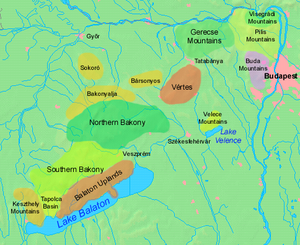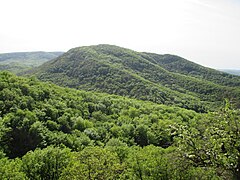Visegrad Mountains
| Visegrad Mountains | ||
|---|---|---|
|
View from Dobogó-kő to the Danube Bend |
||
| Highest peak | Dobogó-kő ( 699 m ) | |
| location | Pest counties , Komárom-Esztergom , Hungary |
|
| part of | Northern Hungarian Central Mountains | |
|
|
||
| Coordinates | 47 ° 45 ' N , 18 ° 58' E | |
| rock | Andesite, pyroclastics | |
The Visegrader Mountains (also Plintenburg Mountains ; Hungarian: Visegrádi-hegység ) is a mountain range on the Danube Bend . Geographically it belongs to the Northern Hungarian Central Uplands , which continues with the Visegrad Mountains west of the Danube .
It is not part of the Transdanubian low mountain range , to whose easternmost foothills, the Pilis Mountains , it is directly adjacent. It is separated from this by the two streams Dera-patak and Szentléleki-patak . The Visegrád Mountains lie on a line between the places Pomáz , a village north of Budapest , and Esztergom . The name of the mountain is derived from the town of Visegrád in Pest County , which is one of the oldest towns in the country of archaeological importance.
geomorphology
The formation of the rocks in the Visegrad Mountains began about 200 million years ago. In the Triassic period , mostly maritime deposits, but also sediments from dry periods, settled. The design of today's surface shape took place around 14-15 million years ago in the Middle Miocene through volcanism . The predominant type of rock is andesite . Thus, the geological structure of the Visegrad Mountains resembles that of the Börzsöny . The shapes of smaller volcanic cones and Lakkolites as well as a mighty caldera can still be reconstructed today.
Based on the chronology of the eruptions, the rock formation can be divided into two phases. Part of the older rocks are made up of cold dykes , sub-volcanic bodies (laccoliths) or lava domes just below the surface . This period also includes extrusions and volcanic debris that formed when the rising magma hit groundwater during eruptions . There were probably violent explosions when the magma came into contact with karst and strata water, as the area is covered with pyroclastics , mainly ignimbrite . The rocks formed in this early phase are mainly compositions of andesite and dacite . The increased occurrence of these types of rock can be demonstrated , for example, in the mountains Strázsa-hegy , Lencse-hegy , Babos-hegy or the Csódi-hegy near Dunabogdány .
The later phase of volcanic rock formation can be divided into two sub-phases. Initially, volcanites were formed that contain pyroxene and amphibole andesite. They are sediments due to pyroclastic flows and block sediments. Also pumice is sometimes to be found there. The remains of a collapsed andesite stratovolcano with a diameter of about 10 km stretch up to the 700 m high ridge of the Dobogó-kő. They can be identified with smaller and larger interruptions from the Urak-Asztal to Nagyvillám .
Products of later volcanic activity are the 639 m high Prédikálószék peak and the Vadálló-kövek rock formation near Dömös. The second subphase is controlled by the Stratovolcano when Keserű-hegy represents whose remains after the reductions in Prédikálószék, Keserű-hegy and Lepence valley ( Lepence-Valley ) from Oreg Pap hegy even during and Matyas-hegy to be found . The Keserű-hegy originated 14-16 million years ago. Most of the rock material is 14 million years old. Until the Pleistocene , the area was free of sediments. Loess was deposited there in the last Ice Age .
The Danube Bend is also part of the Visegráder Mountains. The Danube, which flows near Visegrád and Börzsöny at an altitude of 200-300 m, has carved deep gorges out of the rock there. According to one theory, it is an egpigenetic breakthrough valley , but there are also many arguments against this assumption.
The topography of the Visegrád Mountains differs in several respects from the surface of the Pilis. The number of steep breaks and deep gorges is less, but there are also some impressive gorges in the Visegrad Mountains, such as the Rám Gorge ( rám-szakadék ). The cave systems are also smaller than in the Pilis Mountains. Also worth mentioning are structures of exposed andesite rock protrusions, from which wind and rain have often carved bizarre shapes. Examples of this can be found at Kő-hegy , among others .
caves
A total of 75 naturally formed caves can be found in the Visegrad Mountains. They are not karst caves like most of the caves in Pilis. Their total length is 512 m. The seven artificially created corridors are a total of 513 m long. Most of the caves are located at Dömös, Pomáz (18) and Szentendre (9), 24 in number.
Caves with a length of more than 10 m:
| Hungarian name | rock | Length (m) | Place in the vicinity |
|---|---|---|---|
| Sas-kövi-barlang * | Andesite tuff | 63 | Szentendre |
| Vasas-szakadék ** I | Andesite agglomerate | 50 | Szentendre |
| Apát-kút-völgyi-barlang | Andesite tuff | 40 | Visegrád |
| Vasas-szakadék III | Andesite agglomerate | 29.5 | Szentendre |
| Vasas-szakadék IV | Andesite agglomerate | 25th | Szentendre |
| Vasas-szakadék II | Andesite agglomerate | 25th | Szentendre |
| Ötlyukú-barlang | Andesite agglomerate | 18.5 | Dömös |
| Kőtorony-alatti-barlang | Andesite agglomerate | 16 | Dömös |
| Domini-barlang | Andesite tuffa | 15.9 | Pomáz |
| Dömörkapui-barlang | Andesite | 13 | Szentendre |
| Hársas-zsomboly | Andesite agglomerate | 10.5 | Visegrád |
| Varga-lyuk *** | Andesite agglomerate | 10 | Pilisscent candle |
| Tűfok-barlang | Andesite agglomerate | 10 | Esztergom |
* "Barlang" is the Hungarian word for cave
** "szakadék" means cleft / chasm / throat
*** "lyuk" means hole
habitat
The Visegrad Mountains have more rainfall than the Pilis and the average temperature is slightly lower. As a result, there are more watercourses that carry precipitation into the depressions of the volcanic rock, where pools and smaller lakes form. These represent valuable biotopes , such as the "Round Lake" ( Kerek-tó ) in the Búbánat Valley ( Búbánatvölgy ).
The zonal forest communities hardly deviate from the Pilis. Here, too, mixed oak forests, sessile oak forests and beech forests alternate on the mountain peaks. However, the soils of shallow depth typical of the Pilis Mountains cannot be found in the Visegráder Mountains. In the bush forests on the steeper, more exposed slopes, there is no stone softening . On the warmer mountain slopes, however, oak species that avoid lime are predominant.
Plants found in the Visegrad Mountains are for example the swamp stendrums and the swamp thistle .
The fauna of the mountain regions, with the exception of some arthropods coincidental. Among the invertebrates, the red tube spider ( Eresus cinnaberinus ), the very rare great hawk and the endemic great hawk ( Isophya costata ) should be mentioned. There are also numerous species of butterflies . In addition, the are stone cancer , the loach , the frog , the dice snake , the Ringelnatter and locust lizard (Ablepharus kitaibelii) worth mentioning. There are also some rare species of bats and wild cats . Lynx are also said to have been settled. The bird world includes the zippammer , the common raven and the dipper . Among the rare birds of prey are saker falcon , the booted eagle , the black kite , the short-toed eagle and the honey buzzard to find.
photos
Web links
- Foundation for Dobogókő. Retrieved February 28, 2009 (German, Hungarian, Slovak, English).
- Duna-Ipoly National Park. Retrieved February 28, 2009 (Hungarian, English).









